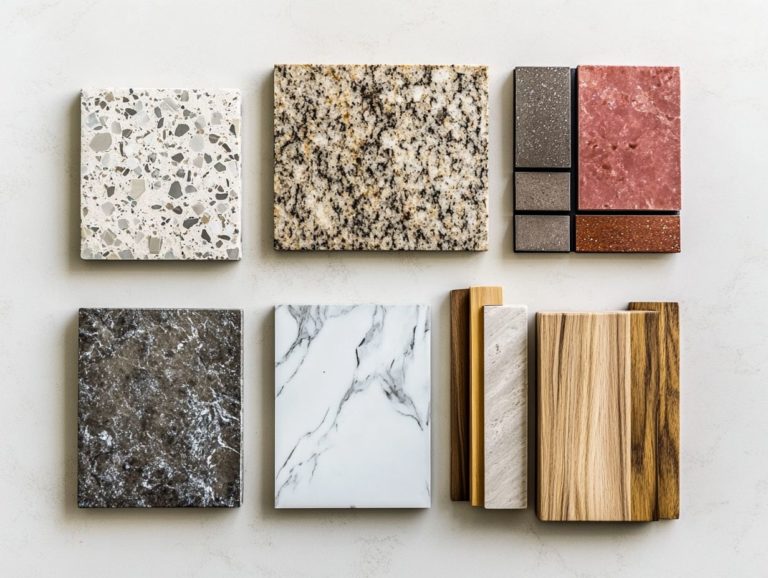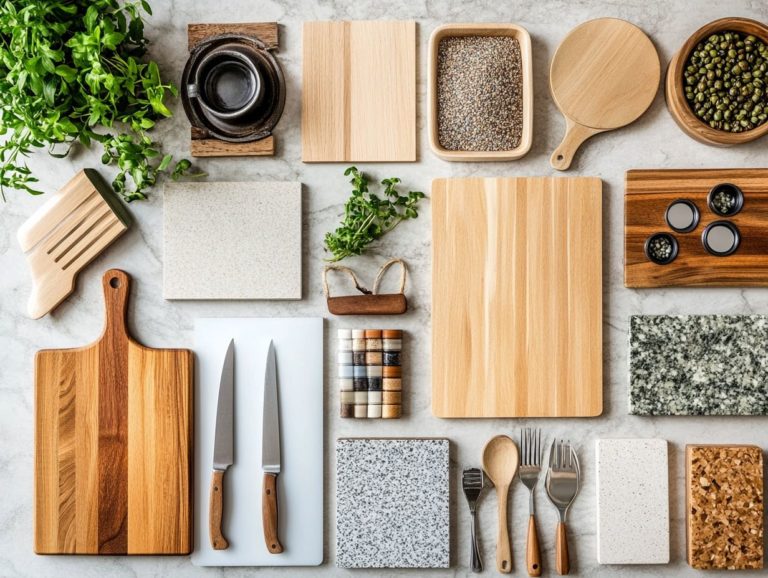The Best Materials for Outdoor Kitchen Spaces
Creating your ideal outdoor kitchen involves a careful choice of materials that harmonize functionality, aesthetics, and durability.
This guide explores the advantages and uses of materials such as stone, wood, and metal. You’ll gain insights to make informed choices for your outdoor space.
Consider your budget and maintenance requirements. Whether you envision a cozy grill nook or a full-fledged culinary haven, you’ll discover ways to enhance your outdoor cooking experience.
Contents
Key Takeaways:

Natural stone is durable and visually appealing, though it may be more costly and require more upkeep than manufactured stone.
Wood offers versatility and affordability, but certain types may suffer from weather damage and need regular maintenance.
Metal materials, like stainless steel, deliver a sleek look while being durable and low-maintenance.
Always consider your budget and desired aesthetic when selecting materials for your outdoor kitchen.
Benefits and Uses
An outdoor kitchen boosts the functionality and enjoyment of your living space.
Imagine the ease of outdoor cooking and the joy of entertaining in a dedicated area. A well-designed outdoor kitchen can transform an ordinary backyard into a lively social hub.
An outdoor kitchen adds value and can increase your home equity, making it a smart investment.
With weather-resistant materials and innovative designs, these kitchens endure the elements and extend your indoor living spaces seamlessly.
Choosing the Right Materials
Choosing the right materials can make your outdoor kitchen last longer and look stunning!
With options like metal frames, wood frames, and concrete blocks, each material offers unique advantages that impact design and durability.
The ideal combination of materials enhances visual appeal and ensures the structure withstands the demands of outdoor living.
Factors to Consider

When designing your outdoor kitchen, consider multiple factors to create a space that is safe, functional, and visually captivating.
Think about elements like outdoor kitchen cabinets, frames, and potential safety hazards to ensure practicality for cooking and entertaining.
Budget and maintenance will significantly influence your material choices. Use durable materials to enhance safety and longevity, while ensuring your design complements the existing landscape.
Proper placement of appliances and workstations can reduce risks associated with heat and movement, making your area user-friendly.
A well-defined budget helps prioritize features like grills, countertops, and storage, balancing luxury and value.
Regular upkeep is essential for maintaining aesthetics and functionality over time. By considering these factors, you can craft an outdoor culinary haven that meets your lifestyle needs.
Stone Materials for Outdoor Kitchens
Stone materials like granite, bluestone, and limestone significantly boost both the aesthetics and functionality of outdoor kitchens, especially countertops.
When choosing between natural stone and manufactured stone, consider durability, maintenance, and cost. Each option has distinct advantages; natural stones offer timeless charm, while manufactured stones can be tailored to your design preferences.
This flexibility makes them a popular choice for outdoor kitchen projects.
Natural Stone vs. Manufactured Stone
Natural stone and manufactured stone each bring unique traits that influence the design of your outdoor kitchen, especially regarding durability and aesthetics.
Natural stones such as granite and limestone are beautiful and strong. In contrast, manufactured stones provide remarkable versatility in design and color. Understanding the differences between these materials is essential for creating an outdoor kitchen that meets both functional needs and aesthetic desires.
Natural stone stands out for its durability, easily withstanding various weather conditions and intense heat. However, this durability often comes with a higher price tag and more maintenance over time.
Manufactured stone, on the other hand, is typically more budget-friendly. It offers a wide array of colors and finishes that can fit seamlessly into any outdoor design vision. Many manufactured options are also lightweight, making installation easier.
Choosing the right materials can transform your outdoor kitchen into a stunning and functional cooking space!
Wood Materials for Outdoor Kitchens

Wood materials infuse outdoor kitchens with warmth and charm, making them a popular choice for structures and cabinetry. However, it’s crucial to consider durability and maintenance carefully.
When selecting wood for your outdoor kitchen cabinets and frames, choose species that can withstand the elements to ensure your project lasts over time.
With proper treatment and care, you can enhance the durability of these wood materials, beautifully combining functionality with aesthetic appeal.
Types of Wood and Their Pros and Cons
Different types of wood, like cedar and teak, come with unique characteristics that affect their suitability for outdoor kitchens. Cedar is naturally resistant to moisture and insects, making it an excellent choice for cabinetry. Teak, on the other hand, offers exceptional durability and a rich, shiny finish.
Understanding these properties is vital for selecting the right wood for your outdoor kitchen projects. The aesthetic qualities of these woods can significantly enhance the ambiance of your cooking space.
Cedar, with its warm tones and inviting aroma, adds rustic charm, while teak, with its golden-brown hues, provides a sophisticated appeal. Cedar requires regular sealing and refinishing, while teak’s natural oils make it low-maintenance.
Weigh these factors carefully, as durability and ease of maintenance can profoundly impact the functionality and beauty of your outdoor kitchen design.
Metal Materials for Outdoor Kitchens
Metal materials such as stainless steel and aluminum are becoming popular choices for outdoor kitchens due to their durability and modern appeal.
These materials excel at resisting corrosion and require minimal upkeep, making them ideal for outdoor cabinetry and frames.
With thoughtful design, metal outdoor kitchens can achieve a sleek, contemporary aesthetic while providing the practicality essential for outdoor cooking.
Ready to design your dream outdoor kitchen? Start planning today!
Popular Metals and Their Durability

Stainless steel and aluminum are top choices for outdoor kitchens. They show great durability and resilience against the elements.
Stainless steel is known for its strength and sleek, modern look. Aluminum is lightweight and rust-resistant, making both metals perfect for your outdoor cooking area.
The shiny finish of stainless steel enhances the contemporary vibe. It beautifully reflects the environment, adding sophistication to your design.
Aluminum, on the other hand, comes in various finishes, allowing you to customize it to match your style—whether rustic or modern.
Both metals are low-maintenance. Stainless steel might need a little polish now and then, while aluminum cleans up easily with soap and water.
Choosing the right metal boosts durability and appearance. It also improves the functionality of your outdoor kitchen, making it an inviting space for entertaining.
Other Considerations
When designing your outdoor kitchen, consider key factors like budget, maintenance, aesthetics, and safety hazards.
Setting a clear budget allows you to invest in quality materials and appliances. Good maintenance practices keep your kitchen functional and looking great.
Prioritizing safety standards helps reduce risks while cooking outdoors. This enhances your overall culinary experience!
Budget, Maintenance, and Aesthetics
Managing your budget, maintenance needs, and design ideas is essential when creating your outdoor kitchen. These factors greatly influence the space’s overall effectiveness and appeal.
A well-planned budget helps you choose outdoor kitchen materials that meet your needs while enhancing your design.
By understanding the maintenance needs of various materials, you can maintain the beauty and functionality of your outdoor kitchen. This balance between cost-effective solutions and luxurious finishes is key to crafting a stunning space.
As you explore material options, think about durability and upkeep. For instance, materials like stainless steel and stone may cost more upfront but save you time and money down the line due to their low maintenance requirements.
Combining durable countertops with weather-resistant cabinetry offers a mix of elegance and practicality.
Planning for seasonal maintenance, such as cleaning and sealing surfaces, keeps your design looking great year after year. This enhances your outdoor kitchen experience for you and your guests!
Frequently Asked Questions
- What are the best materials for outdoor kitchen spaces?
The best materials include stainless steel, natural stone, and concrete. These are durable and weather-resistant! - Why is stainless steel a popular choice for outdoor kitchens?
Stainless steel is rust-resistant and easy to clean. It can handle harsh weather and has a sleek look! - What are the benefits of using natural stone for outdoor kitchen spaces?
Natural stone, like granite or marble, is heat-resistant and durable. It also adds a luxurious touch to your design! - Is concrete a good option for outdoor kitchens?
Concrete is affordable and customizable. It can resist tough weather and can mimic other materials! - What are some other materials for outdoor kitchens?
Tile, wood, and composite materials are great options. Each has unique benefits, like being easy to clean or eco-friendly. - What should I consider when choosing materials for my outdoor kitchen?
Consider durability, weather resistance, maintenance, and design. Don’t forget to keep your budget and style in mind!





